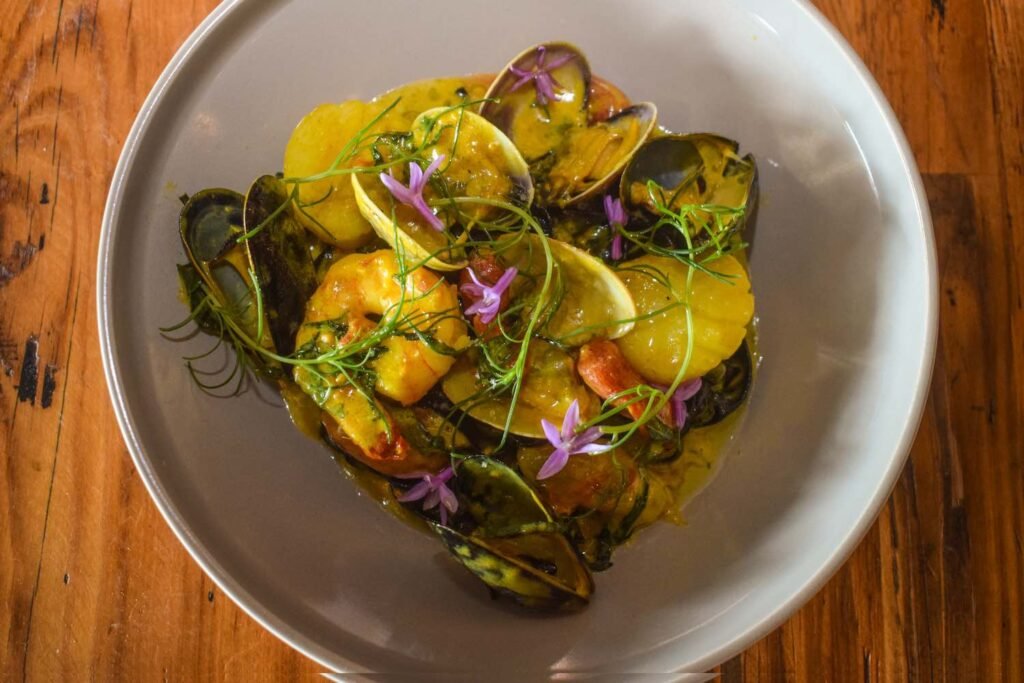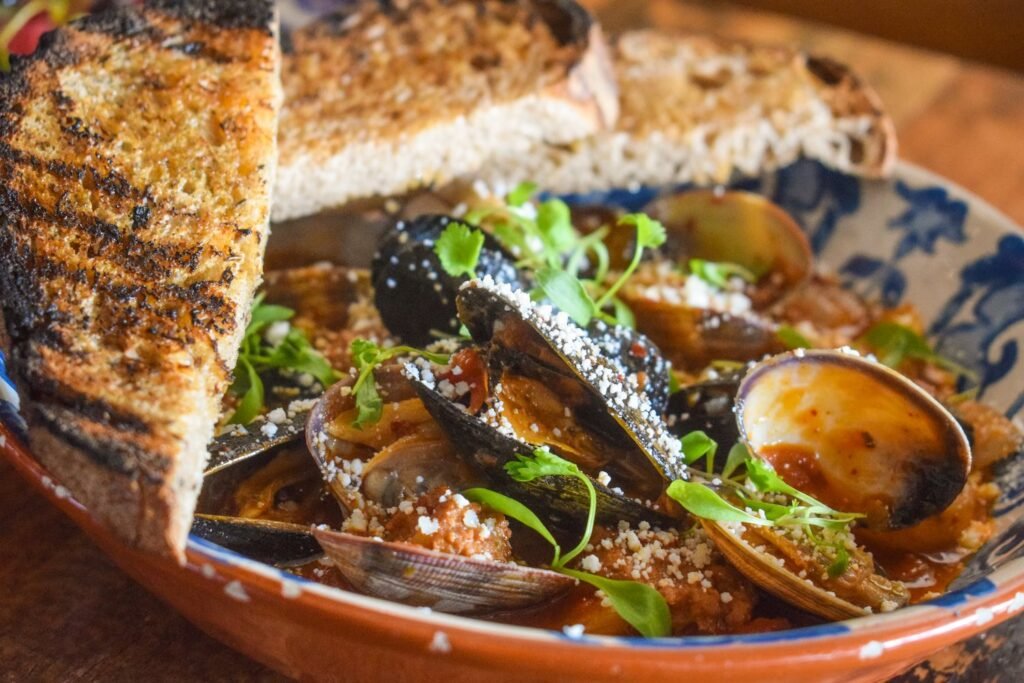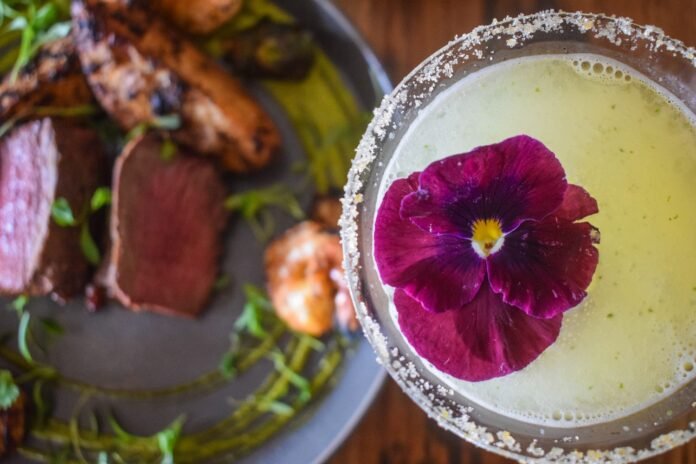Upon entry into Wood & Salt—owner Bjoern Risse’s second Bixby Knolls restaurant alongside the ever-stellar and consistent Rasselbock—you are greeted with the stack of chopped wood, used as an interior touch to the decor along with what is often the literal smell of wood being burned for food prep. There’s the warm touches of a tile-lined bar and, of particular note in the bathroom, some of the most spectacular wallpaper to ever grace a restroom: surreal, tropical animals—flamingos with giraffe necks and heads, elephants mixed with monkeys…
In other words, it is a space that is asking to be used; to be filled with the random guffaws of old friends breaking bread after far too long disconnecting with one another; to be animated.

And when the pandemic’s most challenging prohibitions had been lifted, Risse got his wish: Patrons slammed the restaurant to experience Chef Brian Levin’s Italian-meets-California cuisine—an array of stellar pastas that sat neck-and-neck with wood-fired fishes and meats—only to have the love of Levin’s food only shortly grasped: Facing a family concern that left him with no choice but to leave, Risse has to seek out a new chef.
“There is, by no means, bad blood—on any level,” Risse said of his relationship with Levin. “Life has its courses and I had to reconfigure Wood & Salt’s path with Brian having to take on family duties.”
Enter Chef Phillip Mack.

With experience in SoCal kitchens ranging from the esteemed Patina Group—whose flagship restaurant that anchored the group’s power within food circles closing after serving the Los Angeles region for three decades—to both the Melrose and Fashion Island locations of Fig & Olive, Mack’s experience offers a perfect companion to Wood & Salt’s original, contemporary Californian menu.
And fear not: pastas—which defined Wood & Salt’s initial menu—are still present, if not remaining the shining stars amongst a handful of new dishes which show that the majority of Mack’s food takes on a more minimalist expression versus Levin’s hyper-comfort-food-gone-elevated.

His branzino—skin on, barely salted and lemon-juiced, using the smokiness of the wood oven to provide most of its flavor—sits atop a simple couscous and equally lightly-seasoned chunks of zucchini and zucchini purée, bitter pea tendrils lining the dish as a final touch. It’s a spectacularly summer-centric dish that I wouldn’t have minded the couscous and squash served cold if there were more acid to brighten it up—but I would be hard-pressed to not hold some sense of respect for Mack’s hold on clean, unfussy takes on proteins cooked with smoke and fire.
Pasta can always be sexy—but for a great example of it actually being sexy, look no further than Chef Mack’s gorgeously plated, wonderfully balanced frutti di mare that is easily one of my favorite in the entirety of the city (and, mind you, a city that is quickly becoming a haven for not just good but stellar pasta).
His surf and turf dish—once again exercising the benefits of a wood oven by letting the smoke provide the majority of the flavor in both proteins in the dish—is also an exertion of minimalism: A hangar steak slightly salted, heavily depending on the (genuinely wonderful) chimichurri that acts as a bright green frame for the whole plate, sits among beautifully charred shrimp and potatoes.
These dishes are Mack showcasing his understanding of the namesake of the restaurant in subtle ways. But it is in his shifting of the previous menu—tackling mightily hefty comfort foods that almost seem antithetical to his branzino but still hold onto his clear appreciation of the minimal—as to where Mack shines.

Take, for example, Mack’s squid ink pasta: While sharing the same profoundly deep black dye, gone is the spaghetti which the former dish preferred in favor of a thicker fettuccine. Gone is the former dish which opted for an addictingly acidic red sauce layered with shrimp and fish stock in favor of a silky, outright wondrous saffron sauce that clings to a heap of succulently poached scallops, clams, mussels, and shrimp.
It is hard to not be obsessed with the comfort and layers of this dish.
In fact, if one were to dream up a perfect frutti di mare pasta, this would certainly be atop that dream. Listen: pasta can always be sexy—but for a great example of it actually being sexy, look no further than Mack’s gorgeously plated, wonderfully balanced dish that is easily one of my favorite in the entirety of the city (and, mind you, a city that is quickly becoming a haven for not just good but stellar pasta). It oozes with delicate subtleties that are paired with hammering flavors: light cream and saffron with hefty doses of umami and the ocean.

His lasagna? An homage to the lasagna we wish could mimic. Mack—again, using the namesake of the space: wood and salt—smokes the pork he uses for his ragù beforehand, layering that with ricotta and little else. The result is a genuinely comforting, delightfully smokey version that happily separates itself from the decadent truffle lasagna that preceded it.
A mussels and clams appetizer—doused in a hefty sofrito-meets-tomato broth filled with chunks of lamb sausage and slices of Gusto bread for dipping—is another “maximal” standout: with the Moroccan spices of the marguez paired with the flavor-blanket of the sofrito, it is a genuinely addictive dish that shouldn’t be dismissed simply as an appetizer.

These are the dishes that witness want seems like a minimal chef attempt the maximalism that exemplifies comfort food—and the results are spectacular when Mack executes them with ease.
Wood & Salt remains a solid go-to, even with the shifting of a new leader in the kitchen—and that shift is eased even more with the space’s new cocktail program, a limited but steadily decent array of offerings that range from a stellar mezcal sour to a boozy, lactose-free espresso martini.
The ultimate point isn’t whether Wood & Salt is good—we know it’s one of the best in Bixby Knolls—but that Risse and his team, both here and at Rasselbock down the street, are part of the heart of lifting Bixby Knolls’ culinary scene.
And Chef Mack? Don’t be afraid of that maximalism you exert minimally in some dishes—I know it sounds like a contradiction but it’s rather wonderful to experience.


